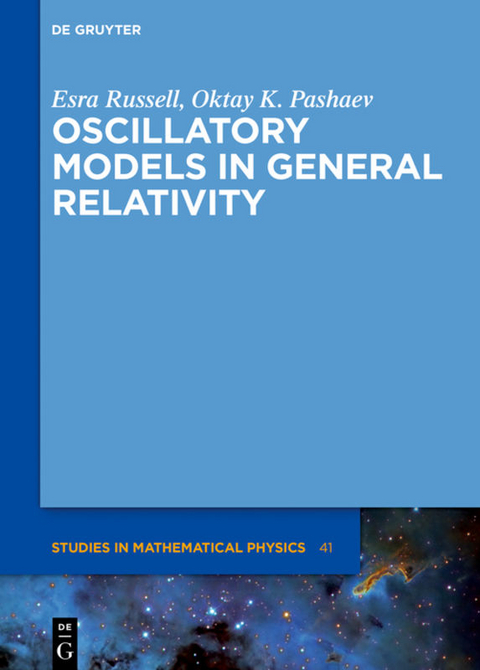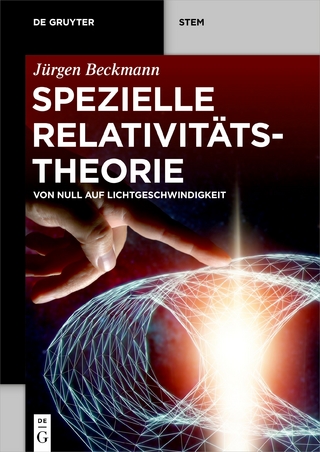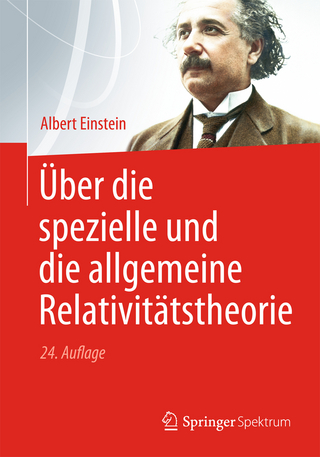Oscillatory Models in General Relativity
De Gruyter (Verlag)
978-3-11-051495-7 (ISBN)
The book employs oscillatory dynamical systems to represent the Universe mathematically via constructing classical and quantum theory of damped oscillators. It further discusses isotropic and homogeneous metrics in the Friedman-Robertson-Walker Universe and shows their equivalence to non-stationary oscillators. The wide class of exactly solvable damped oscillator models with variable parameters is associated with classical special functions of mathematical physics. Combining principles with observations in an easy to follow way, it inspires further thinking for mathematicians and physicists. ContentsPart I: Dissipative geometry and general relativity theoryPseudo-Riemannian geometry and general relativityDynamics of universe modelsAnisotropic and homogeneous universe modelsMetric waves in a nonstationary universe and dissipative oscillatorBosonic and fermionic models of a Friedman–Robertson–Walker universeTime dependent constants in an oscillatory universe Part II: Variational principle for time dependent oscillations and dissipationsLagrangian and Hamilton descriptionsDamped oscillator: classical and quantum theorySturm–Liouville problem as a damped oscillator with time dependent damping and frequencyRiccati representation of time dependent damped oscillatorsQuantization of the harmonic oscillator with time dependent parameters
Esra Russel, New York University Abu Dhabi, United Arab Emirates, Oktay Pashaev, Izmir Institute of Technology, Turkey
Table of content:
Chapter 1 Introduction
Part I Dissipative Geometry and General Relativity Theory
Chapter 2 Pseudo-Riemannian Geometry and General Relativity
2.1. Curvature of Space Time and Einstein Field Equations
2.1.1. Einstein Field Equations
2.1.2. Energy Momentum Tensor
2.2. Universe as a Dynamical System
2.2.1. Friedman-Robertson-Walker (FRW) Metric
2.2.2. Friedman Equations
2.2.3. Adiabatic Expansion and Friedman Differential Equation
Chapter 3 Dynamics of Universe Models
3.1. Friedman Models
3.1.1. Static Models
3.1.2. Empty Models
3.1.3. Three Non-Empty Models with ¤ = 0
3.1.4. Non-Empty Models with ¤ 6= 0
3.2. Milne Model
Chapter 4 Anisotropic and Homogeneous Universe Models
4.1. General Solution
4.1.1. Constant Density and Zero Pressure
4.1.2. Constant Pressure and Zero Density
4.1.3. Absence of Pressure and Density
Chapter 5 Barotropic Models of FRW Universe
5.1. Bosonic FRW Model
5.2. Fermionic FRW Barotropy
5.3. Decoupled Fermionic and Bosonic FRW Barotropies
5.4. Coupled Fermionic and Bosonic Cosmological Barotropies
Chapter 6 Time Dependent Gravitational and Cosmological Constants
6.1. Model and Field Equation
6.2. Solution of the Field Equation
6.2.1. G (t) ~ H
6.2.1.1. Inflationary Phase
6.2.1.2. Radiation Dominated Phase
6.2.2. G (t) ~ 1/H
6.2.2.1. Inflationary Phase
6.2.2.2. Radiation Dominated Phase
Chapter 7 Gravitational Waves in Non-Stationary Universe and Dissipative Oscillator
7.1. Linear Gravitational (Metric) Waves in Flat Space Time
7.2. Linear Gravitational (Metric) Waves in Non-Stationary Universe
7.2.1. Hyperbolic Geometry of Damped Oscillator and Double Universe
Part II Variational Principles for Time Dependent Oscillations and Dissipations
Chapter 8 Lagrangian and Hamilton Description
8.1. Generalized Co-ordinates and Velocities
8.2. Principle of Least Action
8.3. Hamilton's Equations
8.3.1. Poisson Brackets
Chapter 9 Damped Oscillator: Classical Quantum
8.4. Damped Oscillator
8.5. Bateman Dual Description
8.6. Caldirola Kanai Approach for Damped Oscillator
8.7. Quantization of Caldirola-Kanai Damped Oscillator with Constant Frequency and Constant Damping
Chapter 10 Sturm Liouville Problem as Damped Parametric Oscillator
10.1. Sturm Liouville Problem in Doublet Oscillator Representation and Self-Adjoint Form
10.1.1. Particular Cases for Non-Self Adjoint Equation
10.1.2. Variational Principle for Self Adjoint Operator
10.1.3. Particular Cases for Self Adjoint Equation
10.2. Oscillator Equation with Three Regular Singular Points
10.2.1. Hypergeometric Functions
10.2.2. Confluent Hypergeometric Function
10.2.3. Bessel Equation
10.2.4. Legendre Equation
10.2.5. Shifted-Legendre Equation
10.2.6. Associated-Legendre Equation
10.2.7. Hermite Equation
10.2.8. Ultra-Spherical (Gegenbauer) Equation
10.2.9. Laguerre
10.2.10. Associated Laguerre Equation
10.2.11. Chebyshev Equation I
10.2.12. Chebyshev Equation II
10.2.13. Shifted Chebyshev Equation I
Chapter 11 Riccati Representation of Time Dependent Damped Oscillators
11.1. Hypergeometric Equation
11.2. Confluent Hypergeometric Equation
11.3. Legendre Equation
11.4. Associated-Legendre Equation
11.5. Hermite Equation
11.6. Laguerre Equation
11.7. Associated Laguerre Equation
11.8. Chebyshev Equation I
11.9. Chebyshev Equation II
Chapter 12 Conclusion
References
List of Tables
Appendices
Appendix A Preliminaries for Tensor Calculus
A.1. Tensor Calculus
A.2. Calculating Christoffel Symbols from Metric
A.3. Parallel Transport and Geodesics
A.4. Variational Method for Geodesics
A.5. Properties of Riemann Curvature Tensor
A.6. Bianchi Identities; Ricci and Einstein Tensors
A.6.1. Ricci Tensor
A.6.2. Einstein Tensor
Appendix B Riccati Differential Equation
Appendix C Hermited Differential Equation
C.1. Orthogonality
C.2. Even/Odd Functions
C.3. Recurrence Relation
C.4. Special Results
Appendix D Non-Stationary Oscillator Representation of FRW Universe
D.1. Time Dependent Oscillator
D.1.1. Delta Function Potential
Appendix E Bianchi Model: An Alternative Way to Model the Present-Day Universe
E.1. BI Models
E.2. Isotropization of BI models into FRW Universe
E3. Evolution of anisotropic deviations from FRW in decoupling
E3.1 Isotropization criteria of the radiation and matter dominated BI model
Indexing
| Erscheinungsdatum | 26.11.2017 |
|---|---|
| Reihe/Serie | De Gruyter Studies in Mathematical Physics ; 41 |
| Zusatzinfo | 13 col. ill., 10 b/w tbl. |
| Verlagsort | Berlin/Boston |
| Sprache | englisch |
| Maße | 170 x 240 mm |
| Gewicht | 397 g |
| Themenwelt | Naturwissenschaften ► Physik / Astronomie ► Relativitätstheorie |
| Schlagworte | 2017 • Differential Equations • Differential Equations and Dynamical Systems • eBook • Linguistics • Mathematical & Computational • Mathematics • MATHEMATICS / Differential Equations • package • Physics • Physik, Astronomie • Relativitätstheorie • Relativity • Relativity and Gravitational Physics • Science • SCIENCE / Physics |
| ISBN-10 | 3-11-051495-8 / 3110514958 |
| ISBN-13 | 978-3-11-051495-7 / 9783110514957 |
| Zustand | Neuware |
| Informationen gemäß Produktsicherheitsverordnung (GPSR) | |
| Haben Sie eine Frage zum Produkt? |
aus dem Bereich




